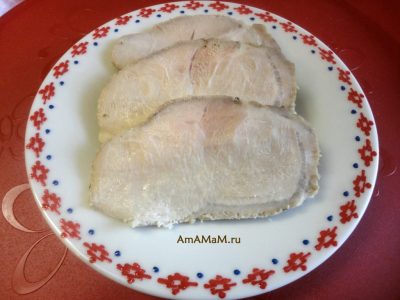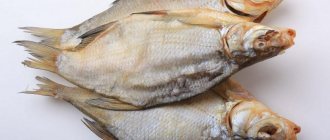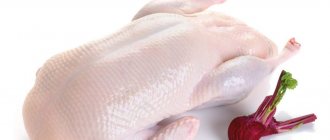How many calories are in carbonate
| product | calorie content | squirrels | fats | carbohydrates |
| boiled-smoked carbonade | 135 kcal | 16.0 g | 8.0 g | 0.0 g |
Boiled-smoked carbonade is a meat delicacy made from unsalted juicy pork. To make carbonate, meat from the dorsal-lumbar cut, usually loin, is used.
How is carbonade made?
Even the name of the product itself hints at the method of its preparation; the word “carbonade” comes from the French word carbonnade, which, in turn, comes from the Latin carbo, which translates as coal. Carbonade is prepared by extinguishing it with dry and warm steam, but previously it was obtained using quiet coal heat.
To make a tasty, high-quality product, you need to choose a certain type of meat that is quick to cook. Therefore, as a rule, carbonade is prepared from pork tenderloin, but sometimes fillet is used, in which case the product should be called pork neck. The low energy value of carbonate is due precisely to the fact that low-fat parts of pork are used for its preparation.
Before cooking, the prepared part of the pig is cleaned of films, trying to preserve a small layer of fat. Then they are breaded with flour, or use a special cloth with flour, or soaked in a mixture of flour, salt, spices, saltpeter and food coloring.
In modern production facilities, meat is treated with dry steam in special chambers and then baked. There are also two more types of carbonate: raw smoked and dry-cured.
This, one might say, dietary delicacy can be prepared at home. Such a product will be as harmless as possible, since it does not contain flavorings, dyes, harmful preservatives and monosodium glutamate.
Beneficial features
Carbonade has a low calorie content, but at the same time it is very nutritious and supplies the body with animal protein. The product is moderately fatty and can be classified as lean meat. Boiled-smoked carbonate is well absorbed and, subject to limited consumption, can be used in the diet. Moderate presence of the product in the diet has a positive effect on the nervous system and also supports the synthesis of vitamins and hormones in the body.
Despite the relatively low fat content and calorie content, carbonate should be used with caution in diseases of the gastrointestinal tract, cholecystitis, atherosclerosis, disorders of the biliary system and renal pathologies. Pork used to prepare carbonate may contain hormones, antibiotics and other substances harmful to health.
The calorie content of 100 grams of pork carbonate (of which 21.1 g protein, 13.0 g fat and 0.0 g carbohydrates) is 201 kcal or 842 kJ. 201 kcal per 100 g is 8.7% of the average daily value.
Chemical composition of carbonate
The exact chemical composition of a product depends on the brand that produces it. Because, in addition to the standard set of proteins, fats, carbohydrates, vitamins and microelements, the components we mentioned earlier can be added to it. Therefore, we can only talk about the approximate chemical composition of the carbonate.
Despite the fact that the product is mainly prepared from pork, it can be called more of a “protein” product.
To verify this, just look at the BJU carbonate per 100 g:
Proteins - 17 g
Carbohydrates - 0 g
Carbonate has a noticeable vitamin composition: mainly B vitamins, as well as vitamins A and C. The product contains most macroelements: potassium, calcium, magnesium, sodium, phosphorus. It is not deprived of carbonate and microelements: its composition is rich in iron, manganese, copper, and zinc.
How to Burn Calories from 100g of Pork Carbonate
For example, to burn all the calories from 100 grams of pork carb, it would take 16 minutes of running or 3 hours and 11 minutes of sleep.
>’>>’>>’>>’>>’>>’>>’>>’>>’>>’>>’>>’>>’>>’>>’>
| Activity | Calorie content per day per 100 g | |
| Dream | 3 hours 11 minutes | 13% |
| Meditation | 2 hours 52 minutes | 12% |
| Rest | 2 hours 37 minutes | 11% |
| Reading books, Internet | 2 hours 12 minutes | 9% |
| Sex | 1 hour 22 minutes | 6% |
| Yoga, Pilates | 0h 54 min | 4% |
| Dancing | 0h 51 min | 4% |
| Walking | 0 h 45 min | 3% |
| Football | 0h 27 min | 2% |
| Swimming | 0h 26 min | 2% |
| Abs workout | 0h 23 min | 2% |
| Power training | 0h 23 min | 2% |
| A ride on the bicycle | 0h 22 min | 2% |
| Jumping rope | 0h 17 min | 1% |
| Run | 0h 16 min | 1% |
Pork carbonate: what it is and recipes

Of all the parts of a pork carcass, carbonade is surpassed in value only by the neck and rump. This meat is suitable for preparing almost any meat dish. This versatility is explained by the delicate texture, leanness and pleasant taste of the pulp.
What is pork chop?
Pork chop is the back part of the animal carcass, that is, the boneless half of the loin. This flesh is located along the ridge from the very head to the rump of the pig. This part of the carcass is highly valued due to the fact that the flesh here is especially tender.
Animals are physiologically designed in such a way that their back muscles are not actually used in the process of life. Accordingly, the fibers of muscle tissue do not become rough in the absence of physical activity and remain soft. And this, in turn, not only gives the meat pulp a special taste, but also significantly reduces the time required for its preparation. In addition, the carbonate almost completely lacks a fat layer, which makes it possible to classify it as dietary meat.
In cooking, carbonade can be used to prepare almost any dish with pork. They fry shish kebab from it, bake it as a whole piece, add it to meat pilaf, and make medallions. If the cooking technology is followed, the meat remains tender, juicy and has a distinct taste.
Cooking recipes
The high demand for pork carbonate has led to the fact that for each dish that is made from it, dozens of different cooking methods are offered. The pages of the Internet are full of numerous recipes and detailed cooking technologies. But there is still a list of pork chop dishes that are rightfully considered the most popular.
Chops braised in wine
This dish can be prepared quite quickly and has a rich taste and aroma. To prepare it you need the following ingredients:
- carbonate – approximately 700-800 g;
- mushrooms (champignons are best) – 500 g;
- meat broth - at least 150 l;
- sweet or semi-sweet wine (preferably dessert) – 100 ml;
- onions – 2 medium onions;
- garlic – 2 cloves;
- flour – 70 g;
- refined sunflower or olive oil – 2-3 tablespoons;
- salt, pepper and other spices to taste.
To prevent the tender meat from falling apart during cooking, the flesh must be cut across the grain. In this case, the pork is cut into the same pieces as for preparing ordinary chops, in which the thickness of the slice is approximately 1 cm. Before slicing, the meat must be thoroughly washed and wiped dry with a paper napkin.
The dish is prepared according to the following scheme:
- To soften the pork, you need to beat it with a hammer on both sides.
- Pour the prepared flour onto the table and carefully roll each piece in it.
- Pour oil into the frying pan and wait until it heats up to the optimal temperature.
- Fry the meat slices in a frying pan on both sides until each is well browned.
- When the chops are ready, remove them from the pan, and instead add chopped onion and garlic (in any way you like) into the oil.
- As soon as the vegetables acquire a golden color, add the mushrooms to them and, stirring thoroughly, simmer everything together for another 10 minutes.
- Add wine to the prepared mushrooms and wait until it starts to boil.
- Pour the broth into the resulting sauce and simmer for another 5 minutes.
- When some of the liquid has evaporated, put the meat back into the pan. It needs to be cooked for another 5-7 minutes on each side.
- Add salt and pepper when stewing. Sprinkle each side of the chops with the spices.
Reference. The finished stew can be served as a separate dish or as a side dish. If desired, you can dilute the taste and aroma with coriander, herbs or purchased mixtures of dry herbs.
Carbonated kebab in tomato sauce
Carbonade is no less in demand for barbecue. The meat cooks quickly on hot coals, and by choosing the right marinade, it can be made soft and juicy.
Carbonated kebab in tomato marinade
A marinade based on tomato sauce benefits in several ways:
- softens meat fibers well;
- requires a minimum amount of ingredients;
- optimally complements the taste of pork.
To prepare shish kebab according to this recipe you will need:
- pork carbonate – 2-2.5 kg;
- tomato juice - at least 0.5 liters per specified volume of meat;
- onion – 5-6 medium-sized onions;
- salt and pepper.
If desired, you can also add special seasonings for kebab. The marinating process follows this plan:
- Rinse the meat thoroughly under running water and wipe dry with a napkin.
- Cut the pulp into equal parts. It is advisable that the size of one piece does not exceed 5-7 cm.
- Place all the pieces in a bowl or pan, sprinkle them with pepper and salt, mix thoroughly so that the spices get on each piece.
- Cut some of the onions into rings and finely chop the remaining ones. Place all this in a bowl with pork and stir.
- Carefully pour tomato juice into the container with the meat.
The juice does not have to completely cover the meat: the marinade will still saturate each piece. But you should remember that it takes a long time for the tomato to be absorbed into the pork. Therefore, it is advisable to marinate 8-10 hours before cooking.
As for the preparation itself, the shish kebab should be cooked over medium heat for 15 to 20 minutes. Moreover, it is advisable to lower the meat to the heat in the first 4-5 minutes and constantly turn it over. This will ensure the formation of a thin crust, which will prevent loss of juice.
Important! The peculiarity of this marinade is that even when frying in a frying pan on the stove, the meat invariably retains its rich taste, remains tender and juicy.
Pork carbonate baked in foil
Unlike conventional baking, cooking such a dish in foil preserves the taste, smell and juice in the meat as much as possible. Accordingly, the food turns out more rich and vibrant.
Carbonate baked in foil
To prepare baked carbonate you need:
- pork – 2 kg;
- tomatoes - 3-4 small fruits;
- tomato paste – about 200 g;
- garlic – 7-8 small cloves;
- wild garlic (in the form of chopped dried herbs) – 20-30 g;
- vegetable oil (preferably olive) – half a tablespoon;
- a mixture of French herbs;
- salt, black pepper and other spices to taste.
Cooking meat this way requires quite a lot of time and effort. Baking takes place according to the technology indicated below:
- Wash the pork thoroughly under running water and dry with a napkin. There is no need to cut the meat. It will bake in one piece.
- Remove the peel from the garlic, chop it and place it in a separate deep plate. Add olive oil there, stir everything thoroughly and leave to infuse for at least 20 minutes.
- Place the tomato, as well as all the prepared herbs and spices, into the resulting garlic oil. Stir the sauce until smooth.
- The carbonade is transferred to a flat surface and thoroughly rubbed on all sides with the previously prepared paste.
- Cut the tomatoes into thin rings and place on top of the pork. For a more pronounced aroma, the meat can be additionally sprinkled with the remnants of wild garlic that were not used for the sauce.
- Carefully wrap the grated pork in foil so as not to break the seal of the package. Place it in the refrigerator for 2-4 hours so that the meat is saturated with the sauce.
- Place the bundle on a baking sheet and place in the oven preheated to 180 degrees. At this temperature, it is enough to bake pork for one hour.
What is typical is that this dish is usually eaten cold, so immediately after baking, without disturbing the wrapper, it is allowed to cool to room temperature. Next, it is sent to the refrigerator, where the meat is infused for another 2 hours.
THIS IS INTERESTING: How many calories are in marmalade
Important! Before serving, the carbonade is cut into slices. As an addition to it, you can serve side dishes, mustard, ketchup, adjika or sauce prepared in advance.
Carbonade is rightfully considered one of the most delicious parts of the pork carcass. Tender and juicy meat without a layer of fat can be consumed even by people on a diet. But when cooking, you must strictly follow the cooking technology, otherwise it is quite easy to spoil the consistency of the meat or dry it out.
Source: https://FermHelp.ru/karbonad-svinoj/
Report errors and inaccuracies
- The calculations use the weight of only the edible part of the product.
Listed below are the nutrient standards that apply to the site.
A product made from unsalted juicy pork is called carbonade. Carbonade is prepared in the same way as boiled pork.
Calorie content of boiled-smoked carbonate
The calorie content of boiled-smoked carbonate is 135 kcal per 100 grams of product.
Composition of boiled-smoked carbonate
Boiled-smoked carbonate contains many macroelements such as: potassium, magnesium, sodium, phosphorus, sulfur, iron. It also contains vitamins: PP, B1, B2 and E.
Useful properties of boiled-smoked carbonate
All these components in boiled-smoked carbonate have a positive effect on metabolism in the human body. And thanks to the moderate amount of fat in carbonate, calcium is well absorbed, and it, in turn, is known to be very important for bone microflora.
How to cook boiled-smoked carbonade
At home, carbonade is prepared in the oven. The advantage of the oven is that the meat comes out more tender, it is well fried, acquires a juicy color, a divine aroma and a bright taste.
The baked carbonade will not leave anyone indifferent. To prepare the carbonate, take the back and lumbar muscles of two chilled pork carcasses. Each muscle weighs about 500-700 grams. The product is soaked in brine for 3-5 days in the freezer at a temperature of 0-4 °C. After that, they hang it in the refrigerator on hooks and keep it for two to four hours so that the skin (calorizer) dries. Smoking lasts for five hours. The most suitable types of wood: cherry, plum, sea buckthorn. The finished semi-finished product is cooked for 60-75 minutes at a temperature of 75-85 ° C until fully cooked.
Other types of carbonate
Carbonade is made not only from pork; beef and pork can also be used. The least high-calorie product made from chicken. Chicken carbonate has a calorie content of about 121 units per 100 grams. However, in a broad sense, carbonate most often refers to a pork product.
By the way, you can often find another name for the product: carbonate. A chemical substance is written with the letter “t” at the end - calcium carbonate. But the name of a flavorful dish made from pork, beef or chicken must end with the letter “d”.
Pork carbonate in the oven calories. Calorie content Pork carbonate
How much does pork carbonate cost (average price per 1 kg)?
Moscow and Moscow region.
Pork carbonade or meat carbonade is usually pork that has been prepared in a special way and intended for long-term storage. In general, the name carbonade itself (although some mistakenly call this product carbonate) has French roots - carbonnade, and from Latin carbo is translated as coal.
It is believed that the name carbonade appeared due to the method of preparing this dish. The fact is that previously, extinguishing with dry warm air or steam, necessary for the production of pork carbonate, could only be carried out with the help of coal - in a quiet coal heat.
Another indispensable condition for making pork carbonate is the presence of a certain type of meat that is quick to cook. That is why carbonade is mainly made from pork tenderloin. Sometimes fillet is also used for these purposes, but then the product is called pork neck. By the way, the low calorie content of carbonate is due to the use of these rather fresh parts of the animal carcass.
In any case, clean meat is first cleaned of existing films, while trying to preserve a layer of fat. After this, a thick breading is created with flour, although often a coating with a thin cloth with flour or an emulsion, which includes table salt, saltpeter, spices (black pepper), and also food coloring, can be used.
In order to improve boiling, pork tenderloin is shaped into a narrow oblong bar or cylinder, which corresponds to the size and cross-section of the natural tenderloin. But this is only relevant if other parts of the animal carcass are used. The calorie content of carbonate is approximately 135 kcal per 100 grams of meat.
For modern meat processing, the production of pork carbonate involves subsequent baking of meat after boiling. However, there is also raw smoked and dry-cured pork carbonate. By the way, cheap varieties of this meat product can often contain soy protein, and to increase the mass, ordinary water is often pumped into it.
Pork carbonate is highly valued by gourmets around the world. For example, in Belgian cuisine there is a dish called Carbonade in Flemish - but this is what it is called in Wallonia and throughout the rest of Europe, and the Flemings themselves are accustomed to simply calling it carbonado. This dish is a pork tenderloin, cut into pieces and stewed in beer sauce.
By the way, any cook can prepare pork carbonate, using not only pork, but even beef or veal. This product combines a variety of spices and vegetables perfectly. Meat also turns out great with a marinade based on tomato juice or chopped onions.
Technology for preparing pork carbonate according to recipe
Let's start preparing with garlic. We clean it and cut each clove lengthwise into several thin pieces. As a result, we should get “garlic petals”. We remove the “petals” on the saucer, we will need them soon.
Pour salt into a separate dry bowl. Add all the ground spices called for in the recipe to the salt. Mix the dry mixture thoroughly. Don't get too carried away with the amount of salt. Not only is it harmful, salt during the baking process will contribute to a large release of meat juice from the future carbonate. For this reason, the product may turn out to be a little dry inside. We need the most tender and aromatic pulp.
Let's get to the meat. The pork must first be removed from the refrigerator (if it was frozen) and defrosted only at room temperature. Then you need to wash the meat under running cold water and place it on a cutting board, remove the films and remove small bones (if they are there).
Calorie content of pork carbonate 135 kcal
Energy value of pork carbonate (ratio of proteins, fats, carbohydrates - bzhu).
Carbonade is a meat delicacy made from pork. As a rule, a cut from the back of a domestic pig is used for these purposes. The presence of fat is allowed, the thickness of the layer should not exceed 5 mm.
Carbonade is a meat delicacy that has become a legend. In distant years, it was carbonate that became the starting point for the conclusion of an alliance between the Russian Empire and China. Representatives of the Chinese government liked the taste so much that after that they began to supply it to China. Russia has always seduced foreign colleagues with the delights of its cuisine.
The history of carbonate as a meat product is shrouded in fairy tales and legends. According to one version, this dish was first prepared by Mitrofan Carbonad for the royal table. And the Russian ruler liked it so much that they began to prepare it constantly. This delicacy was always served at all celebrations, and its “discoverer” Mitrofan received the highest position in the royal kitchen. By order of the Tsar, a meat delicacy was named after Mitrofan - Carbonade.
Calorie content of boiled-smoked carbonate
The calorie content of boiled-smoked carbonate is 135 kcal per 100 grams of product.
Composition of boiled-smoked carbonate
Boiled-smoked carbonate contains many macroelements such as: potassium, magnesium, sodium, phosphorus, sulfur, iron. It also contains vitamins: PP, B1, B2 and E.
A fairly long heat treatment during cooking, of course, negatively affects the nutritional value of this meat delicacy. However, it contains many different biologically active substances, many of which are vital for the human body. This determines that carbonate has a number of beneficial properties, but they will only be so if it is consumed in moderation. In particular, the consumption of this meat product reduces nervous excitability, stimulates the processes of hematopoiesis, metabolism, formation of bone and muscle tissue, and also helps reduce cholesterol levels in the blood, improves the functioning of the heart, blood vessels and gastrointestinal tract.
How to cook boiled-smoked carbonade
At home, carbonade is prepared in the oven. The advantage of the oven is that the meat comes out more tender, it is well fried, acquires a juicy color, a divine aroma and a bright taste.
The baked carbonade will not leave anyone indifferent. To prepare the carbonate, take the back and lumbar muscles of two chilled pork carcasses. Each muscle weighs about 500-700 grams. The product is soaked in brine for 3-5 days in the freezer at a temperature of 0-4 °C. After that, they hang it in the refrigerator on hooks and keep it for two to four hours so that the skin (calorizer) dries. Smoking lasts for five hours. The most suitable types of wood: cherry, plum, sea buckthorn. The finished semi-finished product is cooked for 60-75 minutes at a temperature of 75-85 ° C until fully cooked.
When cooked, carbonade is served either separately or together with other dishes, pre-cut into thin slices. As a complement to this meat delicacy, it is recommended to use various sauces, as well as vegetable side dishes. As a rule, boiled, stewed and fried dishes from cabbage, potatoes or legumes are used for these purposes.
What goes with it?
Carbonade goes well with most popular foods, especially vegetables (potatoes, cabbage, legumes), fruits, berries, mushrooms, sweet and sour and hot sauces, cheese, nuts, honey.
As noted earlier, the most preferred choice for making carbonated meat is pork tenderloin. In this case, you need to pay attention to the color of the pulp, which should not be too light and not too dark. A light color indicates the use of hormonal drugs when raising animals, and a dark color indicates that the meat was taken from an older animal and after cooking it will be tough and tasteless. Another factor of choice is the color and thickness of the fat layer. It must be white and not exceed 5 mm.
When prepared, carbonade should be stored in the refrigerator and consumed within 5-7 days. It is not recommended to freeze this meat product, since after thawing it may taste bitter.
Nutritional value per 100 grams:
Harm and contraindications
Individual intolerance, tendency to an allergic reaction, the need for mandatory heat treatment at a temperature of at least 75 degrees Celsius, diseases of the cardiovascular system (use with caution).
Carbonade is a meat delicacy made from pork. As a rule, a cut from the back of a domestic pig is used for these purposes. The presence of fat is allowed, the thickness of the layer should not exceed 5 mm.
Calorie content
100 grams of carbonate contains about 135 kcal.
Compound
The chemical composition of carbonate is characterized by a high content of proteins, fats, ash, vitamins (A, B1, B3, B5, B9, B12, C), macro- (potassium, calcium, magnesium, sodium, phosphorus) and microelements (iron, manganese, copper , zinc, selenium).
How to cook
Traditionally, carbonade is prepared by extinguishing with dry hot air or steam. At the same time, traditional recipes involve the use of tenderloin for its preparation. However, other parts of the domestic pig carcass can be used for these purposes. The only limitation is the fat content - it should be minimal. The tenderloin is first cleared of existing films, and then it is given an oblong shape, since it contributes to a more uniform distribution of heat inside the meat. Next, it is coated with a mixture of spices. For these purposes, as a rule, salt, pepper, nutmeg or chopped garlic are used. Then the meat is placed in the oven, where it is cooked for 2.5-3 hours at a temperature of 180-200 degrees Celsius. Cooking time can be reduced by 2 times if the pork is pre-boiled.
How to serve
When cooked, carbonade is served either separately or together with other dishes, pre-cut into thin slices. As a complement to this meat delicacy, it is recommended to use various sauces, as well as vegetable side dishes. As a rule, boiled, stewed and fried dishes from cabbage, potatoes or legumes are used for these purposes.
What goes with it?
Carbonade goes well with most popular foods, especially vegetables (potatoes, cabbage, legumes), fruits, berries, mushrooms, sweet and sour and hot sauces, cheese, nuts, honey.
How to choose
As noted earlier, the most preferred choice for making carbonated meat is pork tenderloin. In this case, you need to pay attention to the color of the pulp, which should not be too light and not too dark. A light color indicates the use of hormonal drugs when raising animals, and a dark color indicates that the meat was taken from an older animal and after cooking it will be tough and tasteless. Another factor of choice is the color and thickness of the fat layer. It must be white and not exceed 5 mm.
Storage
When prepared, carbonade should be stored in the refrigerator and consumed within 5-7 days. It is not recommended to freeze this meat product, since after thawing it may taste bitter.
Beneficial features
A fairly long heat treatment during cooking, of course, negatively affects the nutritional value of this meat delicacy. However, it contains many different biologically active substances, many of which are vital for the human body. This determines that carbonate has a number of beneficial properties, but they will only be so if it is consumed in moderation. In particular, the consumption of this meat product reduces nervous excitability, stimulates the processes of hematopoiesis, metabolism, formation of bone and muscle tissue, and also helps reduce cholesterol levels in the blood, improves the functioning of the heart, blood vessels and gastrointestinal tract.
Restrictions on use
Individual intolerance, tendency to an allergic reaction, the need for mandatory heat treatment at a temperature of at least 75 degrees Celsius, diseases of the cardiovascular system (use with caution).
Pork carbonate
rich in vitamins and minerals such as: vitamin B1 - 40%, vitamin B6 - 20%, vitamin PP - 33.5%, potassium - 12.6%, phosphorus - 22.8%, cobalt - 80%, molybdenum - 18 .6%, chromium - 27%, zinc - 17.3%
Calorie content of carbonate per 100 grams
We mentioned above that carbonate has a low calorie content per 100 grams compared to other pork products. It is believed that 100 grams of the product contains approximately 177 kcal. But depending on the manufacturer and method of preparing the carbonate, this figure can vary from 127 to 345 kcal. The energy value of the product also depends on the thickness of the fat layer. Thus, pork carbonate, whose calorie content is over 200 units, already contains more fats, not proteins.
When talking about the energy value of this product, we usually mean the calorie content of boiled-smoked pork carbonate. It is approximately 140 units. But there are other types of product and methods of preparing it, and accordingly, they will have different energy values. Boiled-smoked carbonate has a low calorie content per 100 grams if the fat layer does not exceed 3 mm. Therefore, it is allowed to be consumed on diets. Of course, in small quantities. However, some manufacturers allow a thicker fat layer, resulting in increased energy value. Such a product will no longer be considered dietary.
There are many recipes for home-cooking the dish, it will take some tinkering with it, but it's worth it. Carbonade baked in the oven is especially popular among housewives.
A suitable pork tenderloin will need to be washed, dried, and small cuts made into which to insert a clove of garlic. Rub the pork with a mixture of salt and pepper, carefully wrap it in foil, and bake for about two hours at 200 degrees Celsius. After the carbonade has cooled, it should be placed in the refrigerator for several hours. Then you can make very tasty sandwiches with it. The calorie content of pork carbonate baked in the oven will thus be approximately 234 units.
You can buy another type of product in the store - raw smoked carbonate, its calorie content is approximately 300 units. Pork tenderloin is smoked with cold sawdust smoke; alder and cherry sawdust are mainly used for this.
What are the benefits of Pork Carbonate?
- Vitamin B1
is part of the most important enzymes of carbohydrate and energy metabolism, providing the body with energy and plastic substances, as well as the metabolism of branched amino acids. A lack of this vitamin leads to serious disorders of the nervous, digestive and cardiovascular systems. - Vitamin B6
is involved in maintaining the immune response, processes of inhibition and excitation in the central nervous system, in the transformation of amino acids, the metabolism of tryptophan, lipids and nucleic acids, promotes the normal formation of red blood cells, and maintaining normal levels of homocysteine in the blood. Insufficient intake of vitamin B6 is accompanied by decreased appetite, impaired skin condition, and the development of homocysteinemia and anemia. - Vitamin PP
is involved in redox reactions of energy metabolism. Insufficient vitamin intake is accompanied by disruption of the normal condition of the skin, gastrointestinal tract and nervous system. - Potassium
is the main intracellular ion that takes part in the regulation of water, acid and electrolyte balance, and is involved in the processes of conducting nerve impulses and regulating blood pressure. - Phosphorus
takes part in many physiological processes, including energy metabolism, regulates acid-base balance, is part of phospholipids, nucleotides and nucleic acids, and is necessary for the mineralization of bones and teeth. Deficiency leads to anorexia, anemia, and rickets. - Cobalt
is part of vitamin B12. Activates enzymes of fatty acid metabolism and folic acid metabolism. - Molybdenum
is a cofactor for many enzymes that ensure the metabolism of sulfur-containing amino acids, purines and pyrimidines. - Chromium
is involved in the regulation of blood glucose levels, enhancing the effect of insulin. Deficiency leads to decreased glucose tolerance. - Zinc
is part of more than 300 enzymes and is involved in the processes of synthesis and breakdown of carbohydrates, proteins, fats, nucleic acids and in the regulation of the expression of a number of genes. Insufficient consumption leads to anemia, secondary immunodeficiency, liver cirrhosis, sexual dysfunction, and the presence of fetal malformations. Research in recent years has revealed the ability of high doses of zinc to disrupt the absorption of copper and thereby contribute to the development of anemia.
still hide
You can see a complete guide to the most useful products in the appendix.









